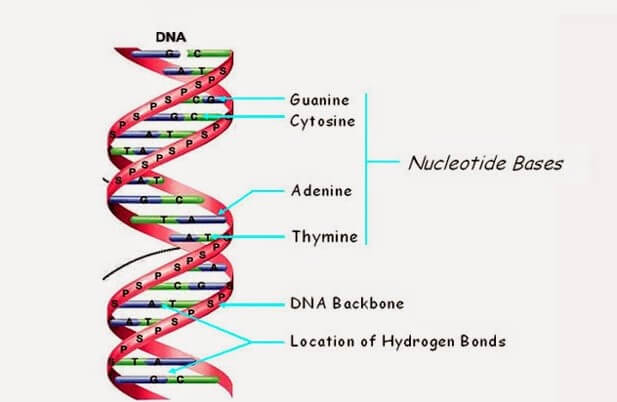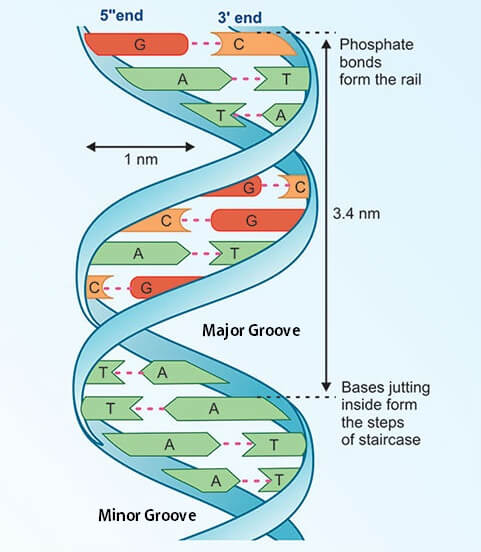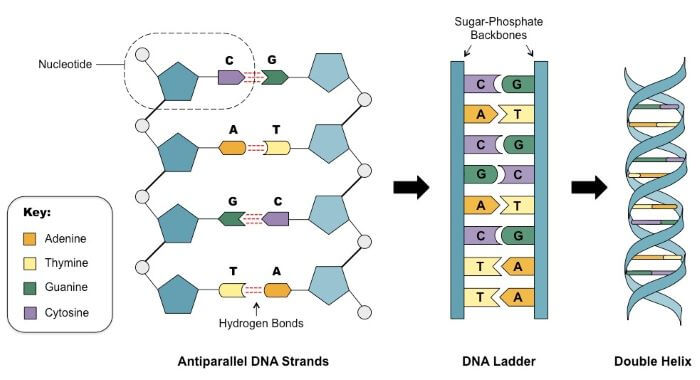DNA Structure | Watson and Crick's model of DNAThe structure of DNA was a mystery before the 1950s. It was at the beginning of 1950s, James Watson (American biologist) and Francis Crick (British physicist) after combining the available physical and chemical data and based on their research introduced the double-helix model for DNA. The work of Rosalind Franklin and Maurice Wilkins helped Watson and Crick in their discovery of the double helix structure of DNA. This model for the DNA structure was widely accepted and is known as Watson and Crick's model of DNA. The three dimensional (3-D) double helix model of DNA as proposed by Watson and Crick including the latest advances in its structure is described below:
The structure of DNA helped understand the various functions of DNA such as how it is replicated and how the information is carried by it is used to make proteins by the cells. Molecular Structure of DNA:DNA is a nucleic acid, which is one of the major groups of biological macromolecules. The DNA molecule has two strands that are tightly packed or coiled into a thread like structure called chromosome and is present in the nucleus of a eukaryotic cell. It is tightly coiled around histone proteins that provide stability to its structure. DNA is visible under a microscope only when the cell is diving as during cell division DNA gets more tightly packed. Each strand of DNA is made up of nucleotides and has two ends; 5' end and a 3' end. DNA has an antiparallel structure that means the two DNA strands are antiparallel and thus run in opposite directions. So, DNA is made up of nucleotides just like a protein is made up of amino acids. It is a bunch of nucleotides that are joined one after another to form spirally coiled DNA strands or chromosome. There are four different nucleotides in DNA. These nucleotides are Adenine, Cytosine, Thymine and Guanine (A, C, T and G). Each nucleotide comprises three simple molecular parts that are a 5-carbon sugar, a phosphate group, and a nitrogenous base. 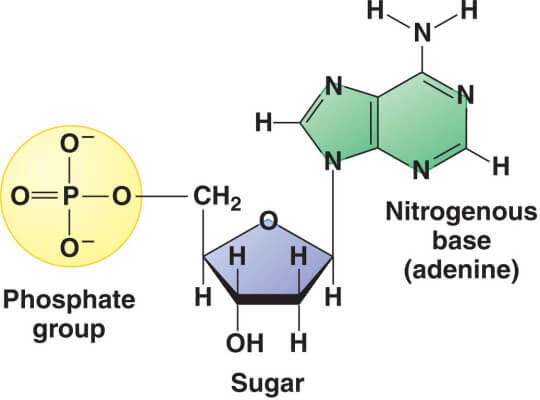
In a nucleotide, the phosphate group and a nitrogenous base are bonded to a sugar molecule to form the nucleotide. The sugar of all four nucleotides is called deoxyribose sugar, which is a cyclical molecule made of one oxygen and four carbons arranged in a ring structure. However, a fifth carbon atom is attached to the fourth carbon of this ring. All nitrogenous bases have the tendency to have multiple nitrogen atoms due to this they are termed as nitrogenous bases. The phosphate group comprises a phosphorus atom that is attached to or bonded with four oxygen atoms. This phosphorus atom tends to bond with other oxygen atoms for example oxygen atom of the deoxyribose sugar of another nucleotide. The four nucleotides of a DNA differ from each other in terms of their nitrogenous bases. Each nucleotide has a different nitrogenous base attached to its deoxyribose sugar and accordingly, they are named as described below:
How nucleotides in DNA are connected to each other? It is the phosphodiester bond that connects the nucleotide monomers in a DNA molecule. This bond always connects the 3' carbon of a nucleotide to the 5' carbon of the next nucleotide. 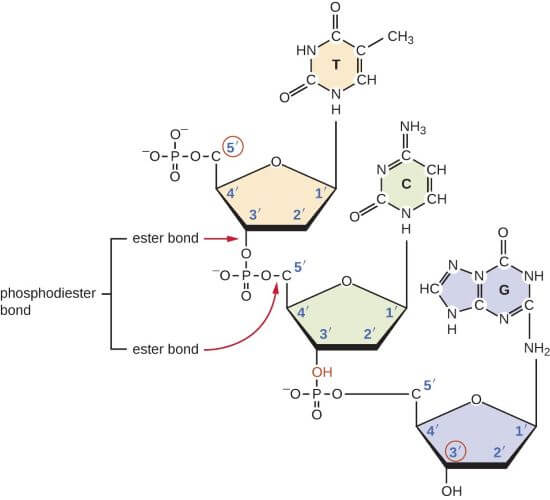
In this bonding, a covalent bond is formed between the oxygen at the 3' carbon of a nucleotide and the phosphorus atom in the phosphate group that is connected at the 5' carbon of the other nucleotide. So, it is called 3'-5' phosphodiester bond. When a nucleotide joins another nucleotide a water molecule is released and this process is known as dehydration synthesis. This process usually happens when polymers are formed. How DNA strands are connected to each other?DNA strands are connected by noncovalent hydrogen bonds between two strands. These bonds strongly connect the two strands to each other and are formed between specific hydrogen atoms on one base (hydrogen bond donors) and specific oxygen or nitrogen atoms (hydrogen bond acceptors) on the other base located on the opposite side on the opposite strand. Both Adenine and Thymine nucleotides have one donor and one acceptor. Cytosine nucleotide has one donor and two acceptors, and Guanine has one acceptor and two donors. The A nucleotides are always connected to T nucleotides through H bonds. Whereas, Cytosine nucleotides are always connected to Guanine nucleotides through H bonds. This type of selective bonding is known as a complementary base pairing that provides stability to the sequence of nucleotides of two DNA strands. The arrows are pointing towards hydrogen (h) bonds; two hydrogen bonds between Thymine and Adenine and three between Cytosine and Guanine. 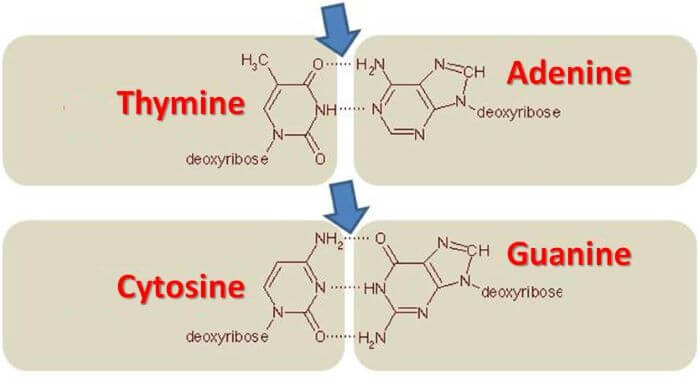
Chargaff's rule:Erwin Chargaff in the 1950s discovered that the quantities of nitrogenous bases of nucleotides (A, T, C and G) were not equal. However, it was found that quantity of A was equal to the amount of T and the amount of C was always equal to the quantity of G. This discovery was very beneficial for understanding the model of the DNA double helix and bonding between bases. Till now, we have understood that two long DNA strands are joined together or spiral to form the double helix structure. Furthermore, DNA can be divided into short segments that are called genes. Gene is a short section or segment of DNA. As DNA molecule is a double-stranded molecule that contains a sequence of bases; A, T, G and C. So, we can say that a gene is a specific sequence of bases. 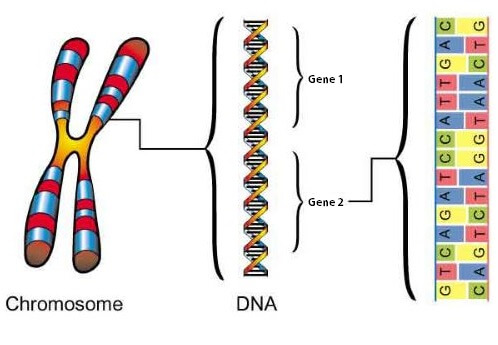
Each gene can be divided into three-nucleotide sub-segments called codons. So, we can say that a codon is a segment or piece of DNA Strand that is three nucleotides long or made of three nucleotides. A gene can be thought of as a string of codons. As there are four nucleotides, there could be 64 different ways in which the four nucleotides of DNA can be arranged. The order or sequence of bases determines DNA's instructions or genetic code. Besides this, DNA strands or molecules are very long. They cannot fit inside the cells without the right packaging. So, they are coiled tightly along with histone proteins to form chromosomes.
Next TopicWhat is Nucleotide
|
 For Videos Join Our Youtube Channel: Join Now
For Videos Join Our Youtube Channel: Join Now
Feedback
- Send your Feedback to [email protected]
Help Others, Please Share




